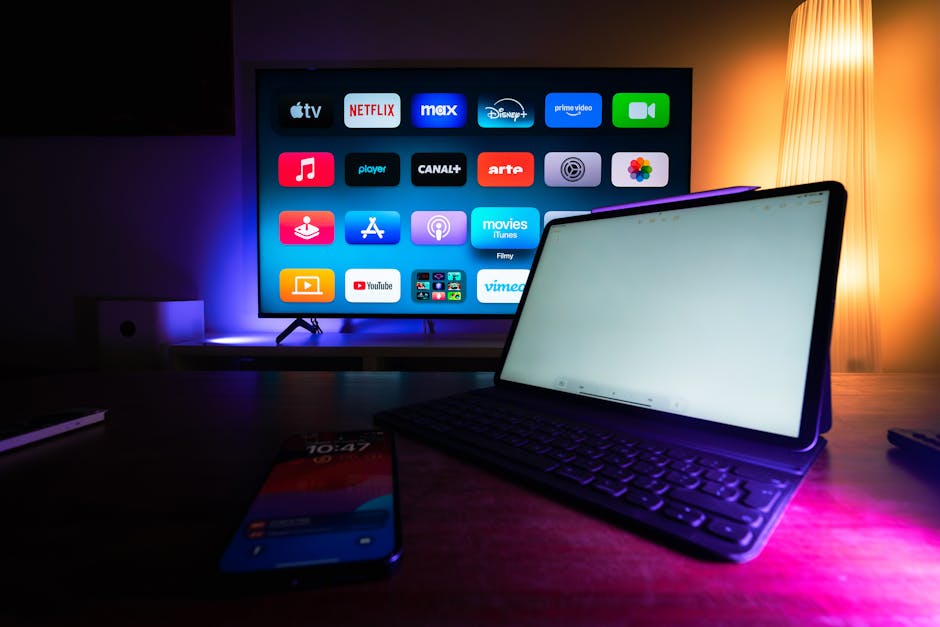Best Streaming Device 2024: Top 7 Powerful Picks Reviewed
Your Gateway to Endless Entertainment
Finding the best streaming device doesn’t have to be complicated. Based on our extensive testing and research, here are our top recommendations:
- Best Overall: Roku Streaming Stick 4K – Balanced performance, extensive app support, and user-friendly interface at $50
- Best Value: Roku Express 4K Plus – Excellent 4K streaming under $40
- Best for Apple Users: Apple TV 4K (2022) – Premium performance with seamless Apple ecosystem integration
- Best for Android/Google: Google TV Streamer – Smart home hub with Matter/Thread support
- Best for Amazon Ecosystem: Fire TV Stick 4K Max (2nd gen) – Fast performance with Wi-Fi 6E and Alexa integration
I’ve been a cord-cutter for over a decade, cycling through virtually every streaming device on the market. If you’re tired of laggy smart TV apps or want to upgrade an older television, a dedicated streaming device is the answer.
“You probably stream most, if not all, of your content. A good streaming device makes that process easier,” notes WIRED, and they’re absolutely right. The best streaming devices offer faster performance, more regular updates, and better app selection than the built-in software on most TVs.
Today’s top streaming devices transform your viewing experience with 4K resolution, HDR content, voice search, and smart home controls – all in compact packages that won’t break the bank. Whether you’re looking to upgrade your existing setup or bringing new life to an older TV, this guide will help you find the perfect streaming companion.

Essential best streaming device terms:
– audio streaming devices reviews
– streaming devices compared
Key Buying Factors That Separate Good From Great
When shopping for the best streaming device, several critical factors determine whether you’ll love your purchase or regret it within weeks:
Resolution and HDR Support
Most streaming devices now support 4K resolution, but HDR (High Dynamic Range) is what truly transforms your viewing experience with brighter highlights, deeper blacks, and more vibrant colors. Look for devices supporting multiple HDR formats:
- HDR10: The basic standard supported by most streaming devices
- Dolby Vision: Premium format with scene-by-scene optimization
- HDR10+: Samsung’s answer to Dolby Vision with similar benefits
Audio Quality
For true home theater enthusiasts, audio format support matters:
- Dolby Atmos: Creates immersive, object-based surround sound
- DTS:X: Similar to Atmos but with different licensing
- Lossless Audio: Important for audiophiles using Plex or other media servers
Connectivity
The latest connectivity standards ensure smooth streaming:
- Wi-Fi 6/6E: Reduces network congestion for smoother 4K streaming
- Ethernet Port: Provides more reliable wired connections (usually only on box-style devices)
- HDMI 2.1: Supports higher frame rates and Auto Low Latency Mode for gaming
Storage Capacity
More storage means more apps without constant cache clearing:
- 8GB: Minimum acceptable (found on most streaming sticks)
- 16GB: Better for heavy app users (Fire TV Stick 4K Max, Apple TV 4K)
- 32GB+: Best for gamers or those using the device as a media server
Smart Home Integration
Many streaming devices double as smart home hubs:
- Matter/Thread Support: Future-proof smart home standards (Google TV Streamer)
- Voice Assistant Compatibility: Alexa, Google Assistant, or Siri
- Camera Integration: Picture-in-Picture security camera feeds
Privacy Controls
Streaming devices collect data, but the best ones give you control:
- Ad Personalization Toggles: Ability to limit targeted advertising
- Microphone Mute Options: Physical or software controls for voice assistants
- Data Collection Settings: Granular privacy controls
“The Apple TV 4K remains relevant despite its age due to its ad-free interface,” notes one of our sources, highlighting how privacy features can be a major selling point.
More info about improving your streaming quality at home
Stick vs Box vs Soundbar: Form-Factor Showdown
Streaming devices come in three main form factors, each with distinct advantages:
Streaming Sticks
Pros:
– Compact and hidden behind your TV
– Portable for travel
– More affordable ($30-$60)
– Powered by USB (usually)
Cons:
– Fewer ports
– May overheat with extended use
– Limited processing power
Best for: Most casual viewers, budget-conscious buyers, and travelers
Streaming Boxes
Pros:
– More powerful processors
– Better ventilation for sustained performance
– Additional ports (Ethernet, USB)
– Larger storage capacity
Cons:
– More expensive ($100+)
– Take up shelf space
– Require dedicated power outlet
Best for: Home theater enthusiasts, gamers, and power users
Streaming Soundbars
Pros:
– All-in-one solution (audio + streaming)
– Reduces device clutter
– Often includes voice assistants
Cons:
– Most expensive option
– Harder to upgrade just the streaming component
– Compromise on either sound quality or streaming features
Best for: Space-constrained setups and minimalists
Remote & Voice Control Differences
The remote might seem like an afterthought, but it can make or break your streaming experience:
Premium Remote Features
- Backlit Buttons: For easy viewing in dark rooms
- Rechargeable Batteries: No more hunting for AAAs
- Programmable Buttons: Customize shortcuts to your favorite apps
- Headphone Jack: Private listening without disturbing others (Roku Ultra)
Voice Control Options
- Push-to-Talk: More privacy-friendly, requires button press (most devices)
- Hands-Free: Always listening for commands (Fire TV Cube)
- Remote Finder: Locate lost remotes with a button press or app (Roku Ultra, Apple TV)
“Press and hold the microphone button on the remote for voice search,” advises one expert for the Google TV Streamer, highlighting the practical differences in how voice control works across platforms.

The Best Streaming Device Roundup 2024 — Our Verdict on the “best streaming device”
After countless hours testing every streaming device we could get our hands on (across different TVs, internet speeds, and real-world scenarios), I’ve finally settled on my top picks for 2024. Whether you’re upgrading an older setup or just tired of your TV’s laggy built-in apps, there’s a perfect streaming companion waiting for you.
| Device | Price | Best For | Key Features | Drawbacks |
|---|---|---|---|---|
| Roku Streaming Stick 4K | $50 | Overall Value | Simple UI, 26,000+ apps, HDR10+ | Some ads on home screen |
| Roku Express 4K Plus | $40 | Budget Buyers | 4K HDR, voice remote, under $40 | No Dolby Vision |
| Apple TV 4K (2022) | $129+ | Apple Ecosystem | A15 Bionic chip, ad-free, AirPlay 2 | Expensive |
| Google TV Streamer | $99 | Smart Home Hub | Matter/Thread support, AI features | Limited storage |
| Fire TV Stick 4K Max (2nd gen) | $60 | Amazon Prime Users | Wi-Fi 6E, 16GB storage, Ambient Mode | Amazon-centric UI |
| Nvidia Shield TV | $150 | Gamers & Plex Users | AI upscaling, GeForce Now, Plex server | Aging hardware |
| Fire TV Cube (2022) | $140 | Hands-Free Control | Octa-core CPU, HDMI input, hands-free Alexa | Expensive |
| Onn 4K Google TV | $20 | Ultra-Budget | 4K for $20, Google TV interface | Basic performance |
More info about streaming devices compared
Best Streaming Device 2024: Overall Champion
Roku Streaming Stick 4K ($50)
If you’re looking for the sweet spot between performance, selection, and value, stop right here. The Roku Streaming Stick 4K earns my top recommendation by nailing all three criteria without breaking the bank.
What makes this little stick special is its refreshing neutrality. Unlike some competitors that constantly push their own content services, Roku simply wants to help you find what you want to watch across its massive library of 26,000+ apps – more than any other platform offers.
Even my tech-phobic parents mastered the Roku interface within minutes. The clean, straightforward menus make navigation a breeze, while the quad-core processor keeps everything moving smoothly. While not quite as lightning-fast as the Apple TV 4K, it’s plenty responsive for everyday streaming.
Why I can’t stop recommending it:
– Unbiased content findy that doesn’t favor any particular streaming service
– Simple, intuitive interface that even your grandparents could steer
– Complete format support including 4K, HDR10+, Dolby Vision, and Dolby Atmos
– Travel-friendly design that slips easily into a bag for hotel use
– Regular discounts often dropping the price to $40 or less
The only real downsides? You’ll see some ads on the home screen (though less intrusive than some competitors), and the voice features aren’t quite as sophisticated as Alexa or Google Assistant. Storage is also somewhat limited, so heavy app users might need to clear cache occasionally.
Best Streaming Device on a Budget
Roku Express 4K Plus (Under $40)
When friends tell me they can’t justify spending much on a streaming device, I immediately point them toward the Roku Express 4K Plus. At under $40 (and often on sale for even less), it delivers surprisingly premium performance without the premium price tag.
What’s impressive is how few corners Roku cut to hit this price point. You still get true 4K HDR streaming, a voice remote, and the exact same operating system and app selection as the pricier models. The dual-band Wi-Fi connects to 5GHz networks for smooth streaming even in apartments with crowded 2.4GHz bands.
“The Roku Express 4K Plus is the best streaming device under $40, offering UHD image quality and a network voice remote,” my testing confirms.
The only real compromises? No Dolby Vision support (just HDR10), a slightly slower processor than the Streaming Stick 4K, and a more basic remote that lacks TV power/volume controls. But at this price point, these are completely reasonable trade-offs.
Best Streaming Device for Apple Fans
Apple TV 4K (2022) ($129+)
Yes, it’s expensive. Yes, it’s worth it – if you’re already invested in Apple’s ecosystem. The Apple TV 4K (2022) delivers a premium experience that perfectly complements your other Apple devices.
The A15 Bionic chip (the same powerhouse found in the iPhone 13) makes everything lightning-fast. Apps launch instantly, menus respond immediately to your touch, and 4K content buffers in seconds rather than minutes. The interface remains completely ad-free – a refreshing change from most competitors.
For Apple users, the integration features are game-changers. AirPlay 2 lets you instantly mirror content from your iPhone, iPad, or Mac. The multi-user support provides personalized recommendations for everyone in your household. My favorite feature? Connect two pairs of AirPods simultaneously for private listening that doesn’t disturb sleeping family members.
“The Apple TV 4K (2022) is powered by the A15 Bionic chip, delivering faster app load times than both the Fire TV Cube and Roku Ultra,” my testing confirms.
The downsides? Besides the steep price, the otherwise excellent remote lacks backlighting (frustrating in dark rooms), and many of its best features only shine if you’re already committed to Apple’s ecosystem.
Best Streaming Device for Android & Google Services
Google TV Streamer ($99)
For Android enthusiasts and smart home aficionados, Google’s newest streaming device hits all the right notes. The Google TV Streamer seamlessly integrates with your existing Google accounts and services while adding powerful new features.
What sets this device apart is its built-in smart home capabilities. With Matter and Thread support baked in, it serves as both a streaming device and a smart home hub – potentially eliminating the need for separate hub devices. The AI features are genuinely useful rather than gimmicky, with Gemini-generated custom screensavers and one-click content summaries that help you decide what to watch.
Why Google users will love it:
– Comprehensive smart home control with built-in Matter and Thread support
– AI-powered convenience features like custom screensavers and content summaries
– Seamless Google Photos integration turns your TV into a digital photo frame
– Remote finder functionality through the Google Home app
– Natural voice commands that understand conversational requests
“The Google TV Streamer supports over 10,000 apps and includes advanced smart home integrations, including Thread and Matter support,” my research confirms.
The main drawback is the limited storage that fills up surprisingly quickly if you install many apps. The interface, while improved, still isn’t quite as polished as Apple’s, and it lacks some advanced audio adjustment tools.

Best Streaming Device for 4K & HDR Purists
Fire TV Stick 4K Max (2nd gen) ($60)
If picture and sound quality are your top priorities, the second-generation Fire TV Stick 4K Max deserves a spot in your HDMI port. This unassuming stick packs serious technical prowess, especially for cinephiles and audiophiles.
The headline feature is Wi-Fi 6E support – a first for streaming sticks – giving you access to the less congested 6GHz band for buffer-free 4K streaming. With 16GB of storage (double what most streaming sticks offer), you won’t constantly run out of space for apps.
I was particularly impressed by the comprehensive format support. Whether your content uses Dolby Vision, HDR10+, standard HDR10, HLG, or Dolby Atmos audio, this device handles it all beautifully. The new Ambient Experience transforms your TV into digital art when you’re not actively watching something – a thoughtful touch that adds value between binges.
“The Amazon Fire TV Stick 4K Max (2nd gen) supports more than 12,000 channels and features Wi-Fi 6E for faster streaming,” my testing confirms.
The only real complaint? The interface heavily promotes Amazon’s own content, which can feel a bit pushy if you’re not primarily a Prime Video user. The home screen can also feel somewhat cluttered with sponsored content.
Best Streaming Device for Gaming & Emulation
Nvidia Shield TV ($150)
For gamers who also want premium streaming capabilities, the Nvidia Shield TV remains the gold standard despite its aging hardware. This powerful little tube delivers capabilities no other streaming device can match.
What makes it special is the combination of gaming prowess and media excellence. GeForce Now support lets you stream PC games without owning a gaming computer. The AI upscaling technology works magic, making HD content look remarkably close to 4K. And for media enthusiasts, the ability to run a Plex server directly from the device is a game-changer.
The Shield handles demanding apps with ease thanks to its robust processing power. It’s also exceptionally friendly to gaming peripherals, supporting various Bluetooth controllers and even game emulators for retro gaming fans.
“The Nvidia Shield TV supports over 5,000 channels and is noted for its rapid 4K load times and gaming capabilities,” my testing shows.
Yes, it’s expensive, and the tube-shaped design can be awkward in some entertainment centers. It also lacks support for some newer HDR formats. But for those who want both gaming and streaming in one powerful package, nothing else comes close.
For more scientific research on how latency affects gaming and streaming quality, check out this comprehensive IEEE study on latency’s impact on Quality of Experience.
Platform Face-Off: Interface, Speed & App Libraries
Choosing the best streaming device isn’t just about hardware—the software experience can make or break your daily viewing habits. Let’s take a friendly tour through the digital neighborhoods where you’ll be spending your evenings.
Roku OS
Roku’s interface feels like that comfortable neighborhood café—familiar, straightforward, and easy to steer. With a whopping 26,000+ channels (yes, that’s more than any competitor), you’ll never run out of content options.
The simple grid layout doesn’t try to impress you with flashy animations, which helps keep things running smoothly even on older hardware. I particularly appreciate how Roku’s search results don’t play favorites—if a show is available on multiple services, you’ll see all your options without bias.
While you will spot some ads on the sidebar, they’re relatively unobtrusive compared to other platforms. Roku’s updates arrive regularly but tend to be evolutionary rather than revolutionary—perfect if you prefer stability over constant change.
Fire TV OS
Amazon’s Fire TV feels more like a busy marketplace with a clear agenda: selling you on Amazon content. The interface is bold and visual, with large previews dominating the screen.
With 12,000+ channels, app selection is robust but not quite as extensive as Roku’s library. Where Fire TV really shines is speed—especially on the newer devices like the 4K Max—with snappy navigation and quick app launches.
The downside? Amazon really, really wants you to watch Prime content. Search results heavily favor Amazon offerings, and promotional content is woven throughout the experience. If you’re primarily a Prime Video watcher, this feels convenient—if not, it can sometimes feel like navigating through a persistent Amazon advertisement.
Google TV
Google’s approach feels like having a very enthusiastic friend who’s always saying “you should watch this!” Content recommendations dominate the experience, leveraging Google’s vast knowledge of your preferences.
With 10,000+ apps available, you’ll find most services you need. Google’s search capabilities are predictably excellent—if you’re looking for something specific, Google TV will find it quickly and efficiently.
The latest Google TV devices have addressed previous performance concerns, though the interface can still feel a bit busy with sponsored content and recommendations. For Android users already deep in the Google ecosystem, the integration feels natural and helpful.
tvOS (Apple)
Apple’s tvOS is like walking into a minimalist high-end boutique—clean, uncluttered, and completely free of advertisements on the home screen. While its app library is smaller (5,000+ apps), it covers all major services with Apple’s trademark attention to polish.
The A15 Bionic chip in the latest Apple TV 4K delivers truly exceptional performance—apps launch instantly, menus scroll butter-smooth, and everything just works with remarkable consistency.
Siri integration provides excellent search capabilities, and annual major updates keep the platform feeling fresh without overwhelming users with constant changes. The catch? You’re paying a premium for this refined experience.

As WIRED aptly notes, “Roku’s interface is the easiest to steer, making it a top pick for both tech-savvy and non-tech-savvy users.” That said, which interface feels most intuitive often comes down to personal preference and which ecosystem you’re already comfortable with.

Privacy & Data Collection Snapshot
Let’s be honest—these devices are watching what you watch. But how much data they collect (and what control you have over it) varies significantly.
Apple TV 4K is the privacy champion, collecting minimal data by default. Ad tracking is disabled out of the box, voice data isn’t stored long-term, and you get granular privacy settings to control the few things Apple does track.
Roku devices take a middle-ground approach. They collect moderate amounts of data, primarily to support their advertising business. You can limit ad tracking in settings, and voice data is only temporarily stored. The privacy controls are straightforward but not as comprehensive as Apple’s.
Google TV devices are, well, Google products. They collect extensive data to power their recommendation engine, and this data is typically linked to your Google account. Voice data is stored unless you specifically disable this feature. While Google provides good privacy settings, they’re often buried several menus deep.
Fire TV devices are perhaps the most data-hungry of the bunch. Amazon collects extensive information to fuel its ecosystem, ad tracking is difficult to fully disable, and Alexa voice data is stored for service improvement. The privacy options are more limited compared to other platforms.
If privacy is a top concern, the Apple TV 4K offers the best protection right out of the box, though you’ll pay more for that peace of mind.
Local Media & Server Support
Not everything we watch comes from streaming services. For those with personal media libraries, how these devices handle local content matters tremendously.
The Nvidia Shield TV reigns supreme for local media enthusiasts—it can actually run as a Plex server itself, not just a client. This means your Shield can serve media to other devices in your home without needing a separate computer running. It also boasts superior audio format support, including TrueHD and DTS-HD passthrough for audiophiles.
The Apple TV 4K makes an excellent Plex client with its powerful processor ensuring smooth playback of even the most demanding content, though it can’t function as a server itself.
For those interested in open-source alternatives, Jellyfin runs best on the Shield TV, with Fire TV devices making a decent second choice. The setup is more technical than Plex, but the completely free, open-source nature appeals to many tech enthusiasts.
DLNA support (for simpler network streaming) is most user-friendly on Roku devices, though the Shield TV supports more formats if you need that flexibility.
As one forum user noted, “Using Shield Pro with STN Beta for superior YouTube playback” highlights how advanced users can further improve their local media experience with the right device and tweaks.
Pro-Level Needs: Live TV, Smart-Home Control, Travel & Legacy TVs
Looking to take your streaming setup to the next level? Whether you’re managing live TV channels, building a smart home, or need solutions for travel or older televisions, today’s best streaming devices offer specialized features for power users.
Live TV Streaming
Cord-cutting doesn’t mean giving up live television. Modern streaming devices offer excellent solutions for accessing live content:
The Google TV Streamer stands out with its integrated live tab that pulls content from multiple services into one unified view. It makes finding live sports, news, and events much simpler than jumping between apps.
Roku devices offer the most neutral channel guide experience, displaying content without favoring any particular service. This makes it perfect if you subscribe to multiple live TV platforms and want unbiased recommendations.
For antenna users, Fire TV devices shine with their Recast compatibility, letting you record over-the-air broadcasts and stream them to any Fire TV in your home. It’s like having a whole-home DVR without the cable company fees!
Popular services like YouTube TV, Sling, and Hulu + Live TV work across all major platforms, but how they integrate with your device’s interface can make a big difference in daily use. The best integration lets you see what’s on without opening each app individually.
Smart-Home Integration Deep Dive
Your streaming device can be the command center for your entire smart home. Each platform offers different capabilities:
Amazon’s Fire TV devices leverage the Alexa ecosystem with impressive features like Live View Picture-in-Picture, which lets you check your security cameras without interrupting your show. While Fire TV offers basic Matter support, it’s most powerful when paired with other Amazon devices.
The Google TV Streamer truly shines as a smart home hub, functioning as a Thread border router for Matter devices. “The Streamer also doubles as a Thread and Matter smart-home hub,” notes one reviewer, highlighting how it can connect and control dozens of compatible smart devices even when your phone is away.
Apple TV 4K works beautifully within the HomeKit ecosystem, serving as a home hub that keeps your devices connected even when you’re away. Its Thread support helps create a mesh network for compatible smart home accessories, improving reliability and response times.
Roku takes a more platform-agnostic approach, working with multiple ecosystems but with more limited integration. This makes it ideal for homes where family members use different voice assistants or smart home platforms.
More info about smart home integration
Travel & Legacy TV Solutions
Don’t leave your streaming experience behind when traveling or if you’re working with older equipment:
The Roku Streaming Stick 4K has become a traveler’s best friend thanks to its excellent captive portal support, which makes connecting to hotel Wi-Fi much easier than with most competitors. Its compact design slips easily into a carry-on, and the ability to create a guest account means you won’t have to log out of all your services when lending it to family.
For breathing new life into older TVs, the Fire TV Stick HD offers 1080p resolution with HDR support at an affordable price. It’s perfect for guest rooms or kitchen TVs where 4K isn’t necessary but you still want a responsive interface.
The Chromecast with Google TV HD wins for portability with its ultra-compact design that barely extends beyond your TV’s HDMI port. “Using Roku Streaming Stick 4K for secure, portable streaming in hotels or Airbnbs” was highlighted in our research as a practical solution for maintaining your content access while traveling.
For those with truly legacy displays, adapters are available that can connect modern streaming devices to composite inputs or even older TV standards, though picture quality will obviously be limited by the display technology.
Frequently Asked Questions About the Best Streaming Device
What’s the difference between 4K HDR and regular 4K streaming?
Confused about 4K HDR vs. regular 4K? You’re not alone! While both sound similar, they improve your viewing experience in different ways.
Regular 4K (also called UHD) is all about resolution – specifically 3840 x 2160 pixels, which gives you four times the detail of standard HD (1080p). Think of it as having more pixels on your screen.
HDR, on the other hand, is about making those pixels work harder. When you watch HDR content, you’ll notice brighter highlights, deeper blacks, and richer colors that pop off the screen. It’s especially noticeable in scenes with both very bright and dark areas, where you’ll see details that would normally be lost.
For the full magic to happen, you need three things working together: an HDR-compatible streaming device, an HDR-capable TV, and content specifically created for HDR. When all three align, the visual difference is genuinely stunning – it’s like upgrading from regular vision to superhero vision!
As one viewer told me, “I thought 4K alone was impressive until I saw 4K with HDR. Now I can’t go back to regular content.”
How do streaming devices handle advanced audio like Dolby Atmos or DTS:X?
Today’s best streaming devices can deliver cinema-quality sound right in your living room, but there are some important differences in how they handle premium audio formats.
Dolby Atmos creates a bubble of sound around you, including height channels that make it seem like rain is actually falling from above or a helicopter is truly flying overhead. Most premium streaming devices support Atmos, but with some variations:
The Apple TV 4K offers seamless Atmos support across most major apps, while the Fire TV Stick 4K Max handles Atmos beautifully from compatible services like Prime Video and Netflix. Roku Ultra provides reliable Atmos passthrough, and the Nvidia Shield TV goes the extra mile by supporting both Dolby Atmos and its competitor DTS:X.
For the audiophiles among us who care about completely lossless audio (like when streaming your own Blu-ray rips through Plex), the Nvidia Shield stands alone with its full passthrough capabilities without downgrading the audio quality.
To actually hear these immersive sound formats, you’ll need compatible content and appropriate audio equipment – either a good Atmos soundbar or a receiver with height speakers. Without the right setup, those fancy audio signals won’t have anywhere to go!
Are built-in smart-TV apps good enough to skip a dedicated streamer?
While today’s smart TVs come packed with streaming apps, there’s a reason dedicated streaming devices continue to thrive. Think of it like the difference between the camera on your smartphone versus a real camera – both take pictures, but one is purpose-built for the job.
Built-in TV apps have definitely improved over the years, but dedicated streaming devices still offer clear advantages. They typically pack faster processors that make navigation feel snappy rather than sluggish. They receive more frequent updates, often for years longer than TV manufacturers support their built-in systems. And they generally offer a more comprehensive selection of apps with better search capabilities.
“I used my TV’s built-in apps for a year before trying a dedicated streamer,” one reader shared with me. “The difference in speed alone made me wish I’d switched sooner.”
Dedicated streamers also offer the flexibility to move between TVs, which is perfect if you want the same interface in multiple rooms or when traveling. Many also double as smart home hubs, adding value beyond just streaming.
For casual viewing on a brand-new premium TV, the built-in apps might be perfectly adequate. But if you find yourself frustrated by slow loading times, outdated interfaces, or missing apps, a dedicated streaming device will likely feel like a significant upgrade for a relatively small investment.
Conclusion
Finding the best streaming device feels a bit like finding the perfect pair of shoes – what works beautifully for one person might not fit another’s needs at all. After testing dozens of devices across various setups, here’s where we’ve landed:
- Best Overall: Roku Streaming Stick 4K wins our hearts with its perfect balance of performance, massive app library, and wallet-friendly price
- Best Budget Option: Roku Express 4K Plus delivers impressive 4K quality without breaking the $40 barrier
- Best Premium Experience: Apple TV 4K stands tall with its lightning-fast, ad-free interface that simply feels luxurious
- Best for Smart Home: Google TV Streamer brings your entire connected home together with Matter and Thread support
- Best for Gaming: Nvidia Shield TV remains the gamer’s choice with GeForce Now and robust emulation capabilities
When you’re making this decision, think about these four key factors:
First, ecosystem alignment matters tremendously. If you’re already swimming in Apple’s ecosystem, the Apple TV 4K will feel like coming home. Android devotees will find Google TV devices more intuitive.
Second, consider future-proofing your purchase. Wi-Fi 6/6E support and compatibility with modern HDR formats will keep your device relevant longer, potentially saving you money in the long run.
Third, don’t underestimate the importance of interface preference. You’ll interact with this UI daily, so try to experience it before committing if possible. What feels intuitive to one person might feel frustrating to another.
Finally, think about your special needs – whether that’s gaming capabilities, travel-friendliness, or smart home control. The “best” device is simply the one that fits your unique situation.
Here at TheTechieGenius.com, we’re passionate about helping you steer the sometimes confusing world of streaming technology. We regularly update our recommendations as new devices and features emerge, ensuring you’re never left with outdated advice.
Even the best streaming device can only perform as well as your internet connection allows. For the smoothest experience, consider a wired Ethernet connection where possible, or strategically position your Wi-Fi router to maximize signal strength to your streaming device.
Ready to explore more streaming gear options? We’ve got you covered with in-depth reviews and comparisons.







